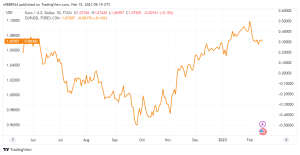In the near future, 1.0700 lines up as the Euro(EURUSD) first major support.
After rising to its highest level in two weeks over 1.0800 with the knee-jerk reaction to US inflation data on Tuesday, Euro (EURUSD)has since lost momentum and fallen around 1.0700. The pair’s near-term technical outlook indicates a lack of buyer interest, and further losses may be seen if the market environment doesn’t get better.
If safe-haven flows continue to predominate, Pair is likely to remain in negative territory.
According to data released on Tuesday by the US Bureau of Labor Statistics, the annual Consumer Price Index (CPI) decreased slightly from 6.5% in December to 6.4% in January. This figure exceeded the market forecast of 6.2% by a small amount. The Core CPI, which excludes volatile food and energy costs, increased 0.4% on a monthly basis, as anticipated. More significantly, the report’s underlying specifics showed that the fundamental The Fed closely monitors services inflation, which was 7.2% on an annual basis. These numbers demonstrated to the markets that the disinflation did not gain any traction in January and served as a reminder that the Federal Reserve is not likely to consider changing its stance on monetary policy.
The US Dollar Index maintains a bullish reading over 103.50, helped by hawkish Fed wagers and increasing US Treasury bond rates. As a result of investors’ risk aversion, US stock index futures are down between 0.4% and 0.7% on the day favorable market conditions for the US dollar. Data on December’s industrial production will be highlighted in the economic docket for Europe.
This information is unlikely to cause the duo to react noticeably unless it comes as a big surprise. The second portion of the day will focus on January retail sales from the US, which are expected to provide fresh momentum. Retail Sales are expected to increase by 1.8% in January after declining by 1.1% in December. A good print might support the US Dollar’s rise and vice versa, even though this data should have little to no bearing on the Fed’s policy stance.
Euro(EURUSD) Technical Analysis
Despite testing this level many times on Tuesday, the EURUSD pair was unable to maintain its position above the four-hour chart’s 50-period Simple Moving Average (SMA). Additionally, the same chart’s Relative Strength Index (RSI) indicator declined below 50, indicating that buyers are still holding off.

1.0700 (a psychological level and the Fibonacci 61.8% retracement of the most recent rise) serves as important support on the downside. 1.0600 and 1.0645/50 (static level) might be reached by another leg down after a four-hour closing below that level (psychological level).
In between 1.0760 (Fibonacci 50% retracement) and 1.0730 (50-period SMA), there is temporary resistance for the pair. If the pair manages to overcome the latter resistance, it is expected to run into another significant obstacle at 1.0775, which is where the 200-period SMA lies.








